Enterprise Architecture: Zachman Framework and HP Norway Analysis
VerifiedAdded on 2020/05/28
|9
|2102
|241
Report
AI Summary
This report provides a comprehensive analysis of the enterprise architecture of HP Norway, focusing on the challenges and strategies associated with the company's office relocation. The analysis employs the Zachman Framework to structure and evaluate the current state of the enterprise, identifying key issues such as the need for increased efficiency in global business operations, the selection of appropriate technologies, and the reorganization of teams post-merger. The report also utilizes a strategy map, integrating a balanced scorecard approach to assess performance across financial, customer, internal process, and learning and growth perspectives. This includes a detailed examination of key performance indicators (KPIs) and objectives for each perspective. The report emphasizes the benefits of the Zachman Framework in classifying and organizing business processes, facilitating efficient management, and providing a structured approach to addressing complex organizational changes. The conclusion highlights the framework's utility in strategic planning and decision-making for enterprise architecture, supporting the integration of business and IT for improved performance and alignment.
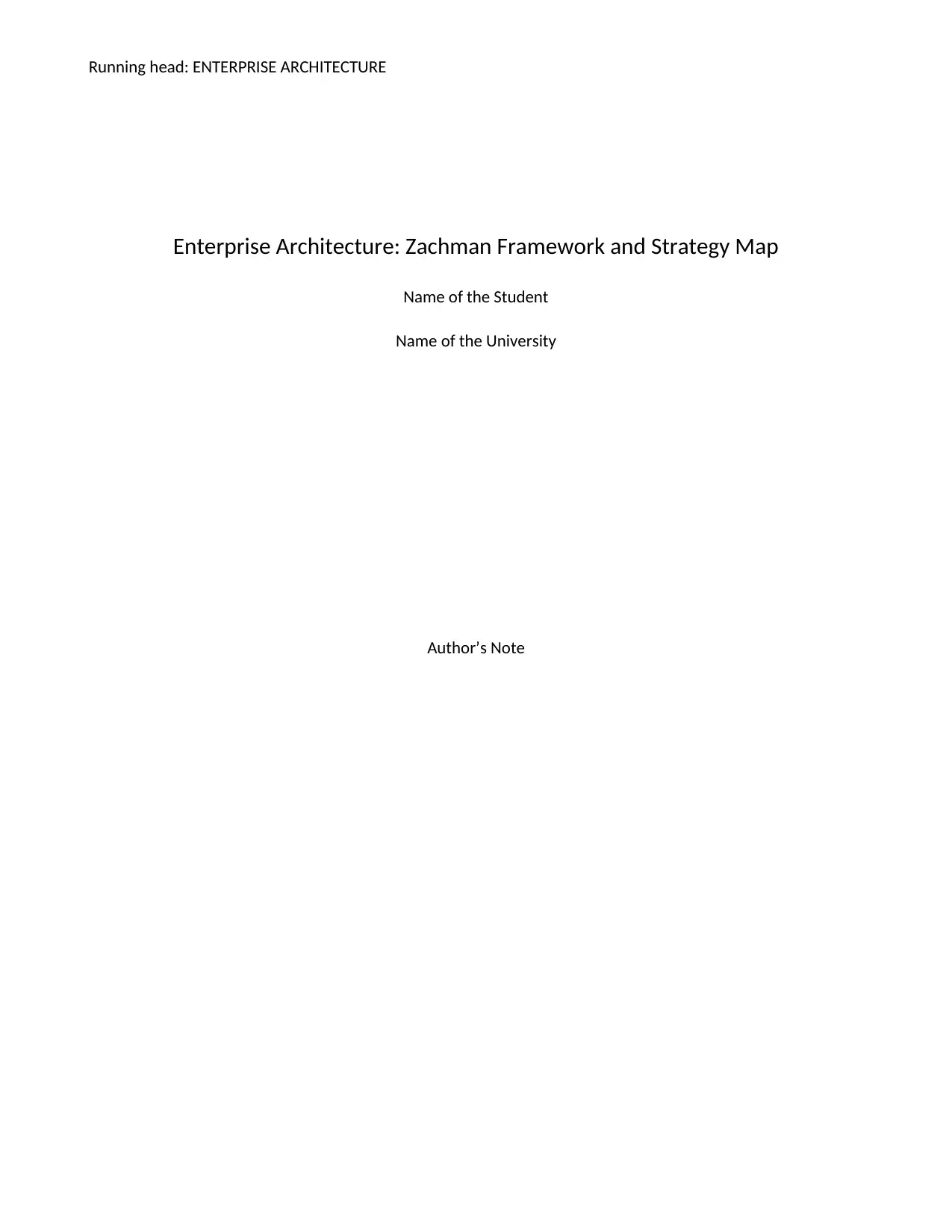
Running head: ENTERPRISE ARCHITECTURE
Enterprise Architecture: Zachman Framework and Strategy Map
Name of the Student
Name of the University
Author’s Note
Enterprise Architecture: Zachman Framework and Strategy Map
Name of the Student
Name of the University
Author’s Note
Paraphrase This Document
Need a fresh take? Get an instant paraphrase of this document with our AI Paraphraser
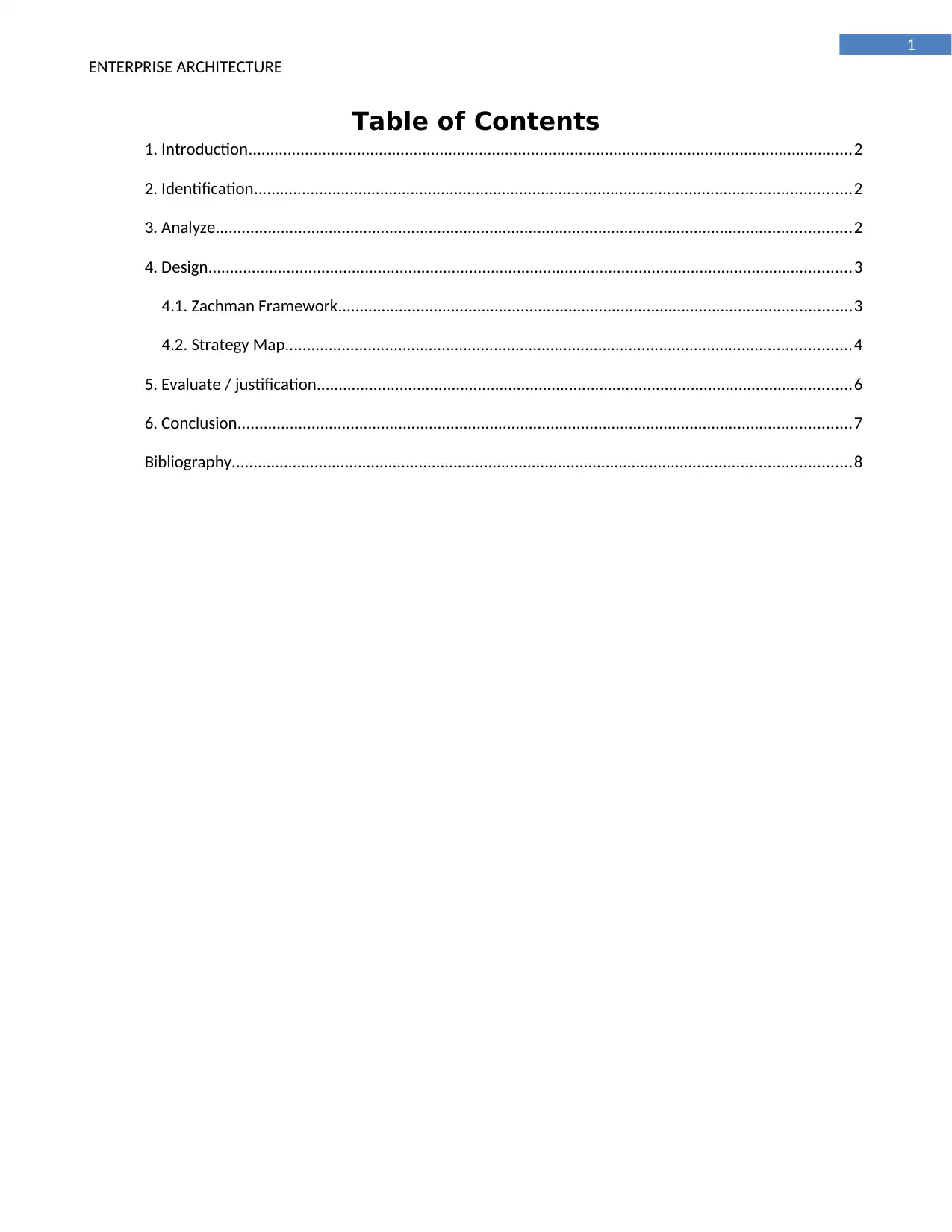
1
ENTERPRISE ARCHITECTURE
Table of Contents
1. Introduction...........................................................................................................................................2
2. Identification.........................................................................................................................................2
3. Analyze..................................................................................................................................................2
4. Design....................................................................................................................................................3
4.1. Zachman Framework......................................................................................................................3
4.2. Strategy Map..................................................................................................................................4
5. Evaluate / justification...........................................................................................................................6
6. Conclusion.............................................................................................................................................7
Bibliography..............................................................................................................................................8
ENTERPRISE ARCHITECTURE
Table of Contents
1. Introduction...........................................................................................................................................2
2. Identification.........................................................................................................................................2
3. Analyze..................................................................................................................................................2
4. Design....................................................................................................................................................3
4.1. Zachman Framework......................................................................................................................3
4.2. Strategy Map..................................................................................................................................4
5. Evaluate / justification...........................................................................................................................6
6. Conclusion.............................................................................................................................................7
Bibliography..............................................................................................................................................8
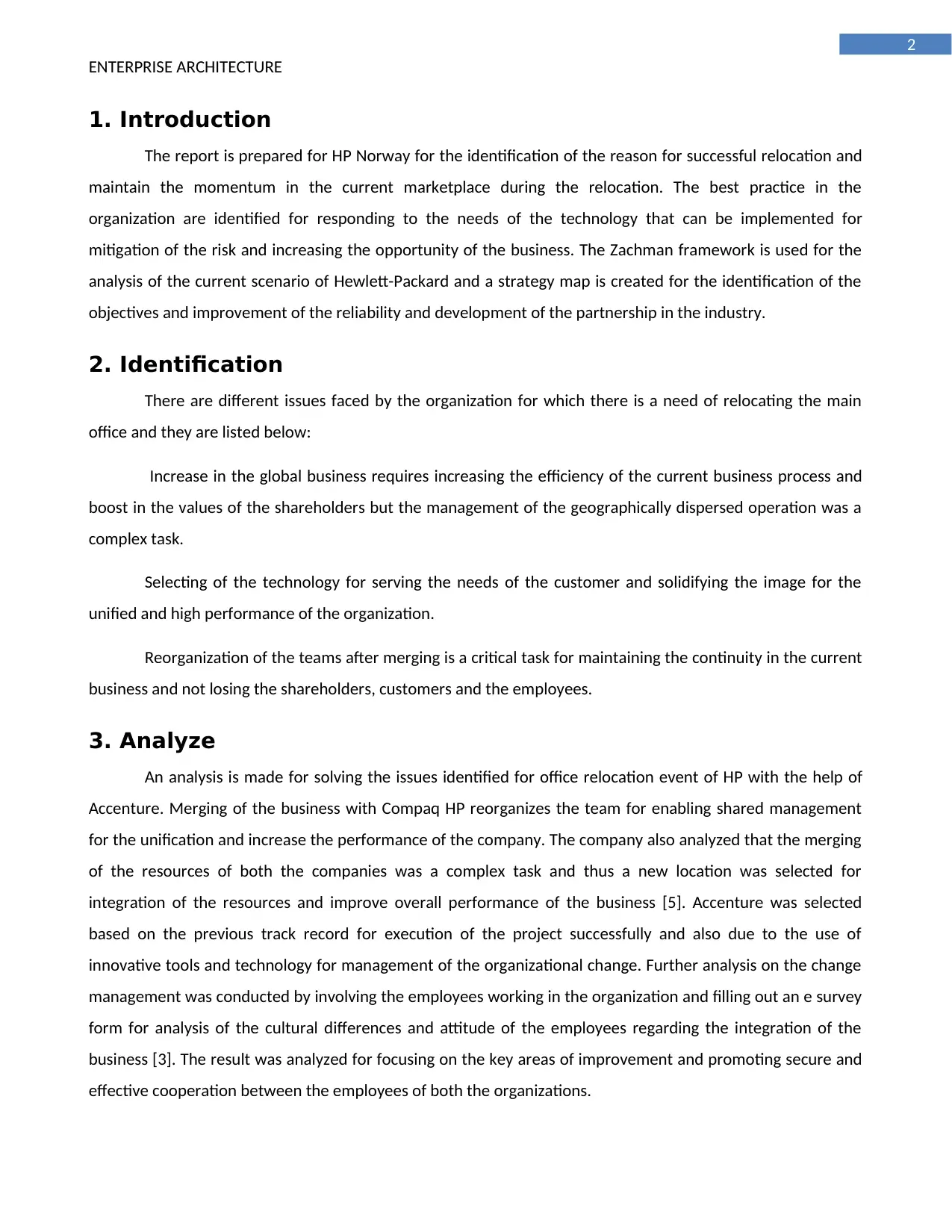
2
ENTERPRISE ARCHITECTURE
1. Introduction
The report is prepared for HP Norway for the identification of the reason for successful relocation and
maintain the momentum in the current marketplace during the relocation. The best practice in the
organization are identified for responding to the needs of the technology that can be implemented for
mitigation of the risk and increasing the opportunity of the business. The Zachman framework is used for the
analysis of the current scenario of Hewlett-Packard and a strategy map is created for the identification of the
objectives and improvement of the reliability and development of the partnership in the industry.
2. Identification
There are different issues faced by the organization for which there is a need of relocating the main
office and they are listed below:
Increase in the global business requires increasing the efficiency of the current business process and
boost in the values of the shareholders but the management of the geographically dispersed operation was a
complex task.
Selecting of the technology for serving the needs of the customer and solidifying the image for the
unified and high performance of the organization.
Reorganization of the teams after merging is a critical task for maintaining the continuity in the current
business and not losing the shareholders, customers and the employees.
3. Analyze
An analysis is made for solving the issues identified for office relocation event of HP with the help of
Accenture. Merging of the business with Compaq HP reorganizes the team for enabling shared management
for the unification and increase the performance of the company. The company also analyzed that the merging
of the resources of both the companies was a complex task and thus a new location was selected for
integration of the resources and improve overall performance of the business [5]. Accenture was selected
based on the previous track record for execution of the project successfully and also due to the use of
innovative tools and technology for management of the organizational change. Further analysis on the change
management was conducted by involving the employees working in the organization and filling out an e survey
form for analysis of the cultural differences and attitude of the employees regarding the integration of the
business [3]. The result was analyzed for focusing on the key areas of improvement and promoting secure and
effective cooperation between the employees of both the organizations.
ENTERPRISE ARCHITECTURE
1. Introduction
The report is prepared for HP Norway for the identification of the reason for successful relocation and
maintain the momentum in the current marketplace during the relocation. The best practice in the
organization are identified for responding to the needs of the technology that can be implemented for
mitigation of the risk and increasing the opportunity of the business. The Zachman framework is used for the
analysis of the current scenario of Hewlett-Packard and a strategy map is created for the identification of the
objectives and improvement of the reliability and development of the partnership in the industry.
2. Identification
There are different issues faced by the organization for which there is a need of relocating the main
office and they are listed below:
Increase in the global business requires increasing the efficiency of the current business process and
boost in the values of the shareholders but the management of the geographically dispersed operation was a
complex task.
Selecting of the technology for serving the needs of the customer and solidifying the image for the
unified and high performance of the organization.
Reorganization of the teams after merging is a critical task for maintaining the continuity in the current
business and not losing the shareholders, customers and the employees.
3. Analyze
An analysis is made for solving the issues identified for office relocation event of HP with the help of
Accenture. Merging of the business with Compaq HP reorganizes the team for enabling shared management
for the unification and increase the performance of the company. The company also analyzed that the merging
of the resources of both the companies was a complex task and thus a new location was selected for
integration of the resources and improve overall performance of the business [5]. Accenture was selected
based on the previous track record for execution of the project successfully and also due to the use of
innovative tools and technology for management of the organizational change. Further analysis on the change
management was conducted by involving the employees working in the organization and filling out an e survey
form for analysis of the cultural differences and attitude of the employees regarding the integration of the
business [3]. The result was analyzed for focusing on the key areas of improvement and promoting secure and
effective cooperation between the employees of both the organizations.
⊘ This is a preview!⊘
Do you want full access?
Subscribe today to unlock all pages.

Trusted by 1+ million students worldwide
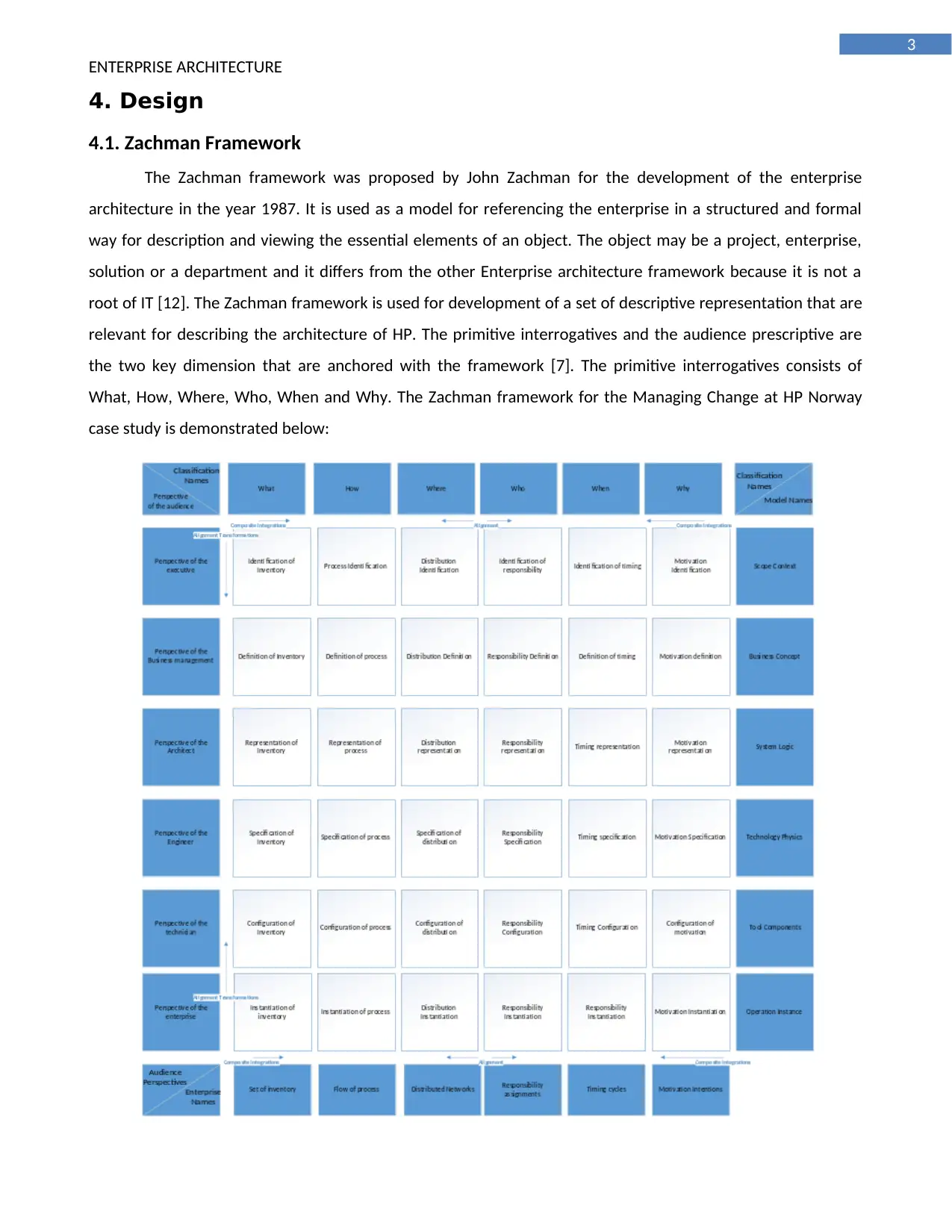
3
ENTERPRISE ARCHITECTURE
4. Design
4.1. Zachman Framework
The Zachman framework was proposed by John Zachman for the development of the enterprise
architecture in the year 1987. It is used as a model for referencing the enterprise in a structured and formal
way for description and viewing the essential elements of an object. The object may be a project, enterprise,
solution or a department and it differs from the other Enterprise architecture framework because it is not a
root of IT [12]. The Zachman framework is used for development of a set of descriptive representation that are
relevant for describing the architecture of HP. The primitive interrogatives and the audience prescriptive are
the two key dimension that are anchored with the framework [7]. The primitive interrogatives consists of
What, How, Where, Who, When and Why. The Zachman framework for the Managing Change at HP Norway
case study is demonstrated below:
ENTERPRISE ARCHITECTURE
4. Design
4.1. Zachman Framework
The Zachman framework was proposed by John Zachman for the development of the enterprise
architecture in the year 1987. It is used as a model for referencing the enterprise in a structured and formal
way for description and viewing the essential elements of an object. The object may be a project, enterprise,
solution or a department and it differs from the other Enterprise architecture framework because it is not a
root of IT [12]. The Zachman framework is used for development of a set of descriptive representation that are
relevant for describing the architecture of HP. The primitive interrogatives and the audience prescriptive are
the two key dimension that are anchored with the framework [7]. The primitive interrogatives consists of
What, How, Where, Who, When and Why. The Zachman framework for the Managing Change at HP Norway
case study is demonstrated below:
Paraphrase This Document
Need a fresh take? Get an instant paraphrase of this document with our AI Paraphraser
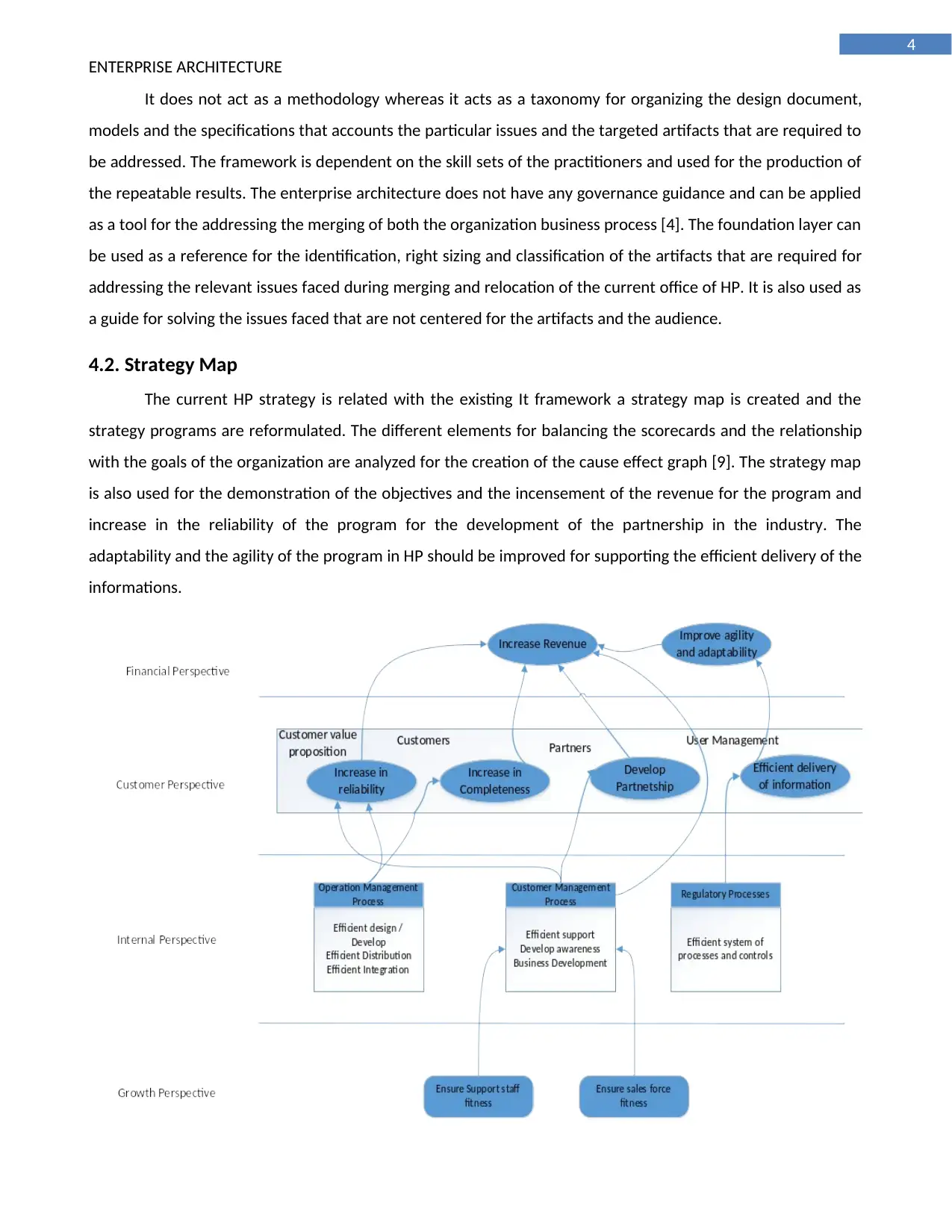
4
ENTERPRISE ARCHITECTURE
It does not act as a methodology whereas it acts as a taxonomy for organizing the design document,
models and the specifications that accounts the particular issues and the targeted artifacts that are required to
be addressed. The framework is dependent on the skill sets of the practitioners and used for the production of
the repeatable results. The enterprise architecture does not have any governance guidance and can be applied
as a tool for the addressing the merging of both the organization business process [4]. The foundation layer can
be used as a reference for the identification, right sizing and classification of the artifacts that are required for
addressing the relevant issues faced during merging and relocation of the current office of HP. It is also used as
a guide for solving the issues faced that are not centered for the artifacts and the audience.
4.2. Strategy Map
The current HP strategy is related with the existing It framework a strategy map is created and the
strategy programs are reformulated. The different elements for balancing the scorecards and the relationship
with the goals of the organization are analyzed for the creation of the cause effect graph [9]. The strategy map
is also used for the demonstration of the objectives and the incensement of the revenue for the program and
increase in the reliability of the program for the development of the partnership in the industry. The
adaptability and the agility of the program in HP should be improved for supporting the efficient delivery of the
informations.
ENTERPRISE ARCHITECTURE
It does not act as a methodology whereas it acts as a taxonomy for organizing the design document,
models and the specifications that accounts the particular issues and the targeted artifacts that are required to
be addressed. The framework is dependent on the skill sets of the practitioners and used for the production of
the repeatable results. The enterprise architecture does not have any governance guidance and can be applied
as a tool for the addressing the merging of both the organization business process [4]. The foundation layer can
be used as a reference for the identification, right sizing and classification of the artifacts that are required for
addressing the relevant issues faced during merging and relocation of the current office of HP. It is also used as
a guide for solving the issues faced that are not centered for the artifacts and the audience.
4.2. Strategy Map
The current HP strategy is related with the existing It framework a strategy map is created and the
strategy programs are reformulated. The different elements for balancing the scorecards and the relationship
with the goals of the organization are analyzed for the creation of the cause effect graph [9]. The strategy map
is also used for the demonstration of the objectives and the incensement of the revenue for the program and
increase in the reliability of the program for the development of the partnership in the industry. The
adaptability and the agility of the program in HP should be improved for supporting the efficient delivery of the
informations.
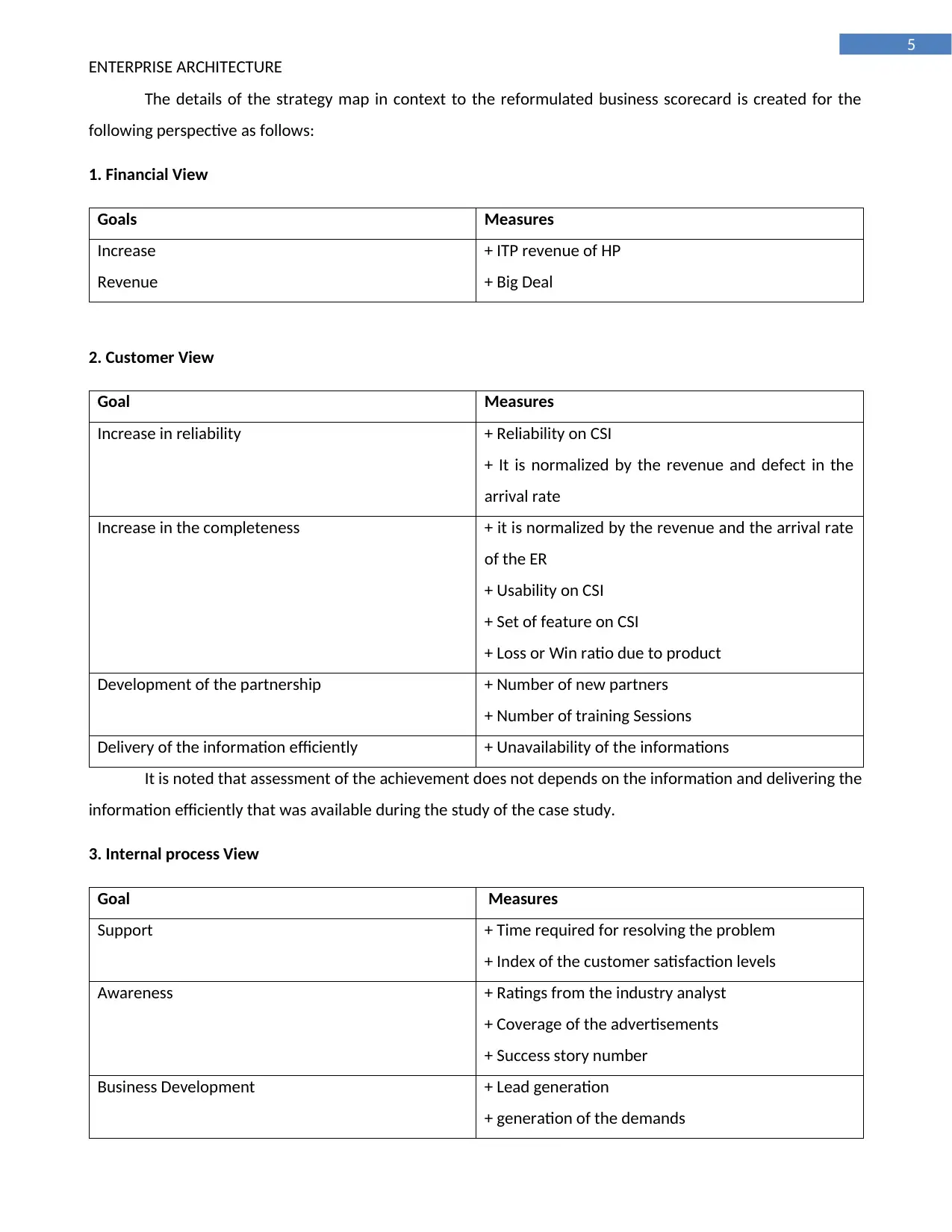
5
ENTERPRISE ARCHITECTURE
The details of the strategy map in context to the reformulated business scorecard is created for the
following perspective as follows:
1. Financial View
Goals Measures
Increase
Revenue
+ ITP revenue of HP
+ Big Deal
2. Customer View
Goal Measures
Increase in reliability + Reliability on CSI
+ It is normalized by the revenue and defect in the
arrival rate
Increase in the completeness + it is normalized by the revenue and the arrival rate
of the ER
+ Usability on CSI
+ Set of feature on CSI
+ Loss or Win ratio due to product
Development of the partnership + Number of new partners
+ Number of training Sessions
Delivery of the information efficiently + Unavailability of the informations
It is noted that assessment of the achievement does not depends on the information and delivering the
information efficiently that was available during the study of the case study.
3. Internal process View
Goal Measures
Support + Time required for resolving the problem
+ Index of the customer satisfaction levels
Awareness + Ratings from the industry analyst
+ Coverage of the advertisements
+ Success story number
Business Development + Lead generation
+ generation of the demands
ENTERPRISE ARCHITECTURE
The details of the strategy map in context to the reformulated business scorecard is created for the
following perspective as follows:
1. Financial View
Goals Measures
Increase
Revenue
+ ITP revenue of HP
+ Big Deal
2. Customer View
Goal Measures
Increase in reliability + Reliability on CSI
+ It is normalized by the revenue and defect in the
arrival rate
Increase in the completeness + it is normalized by the revenue and the arrival rate
of the ER
+ Usability on CSI
+ Set of feature on CSI
+ Loss or Win ratio due to product
Development of the partnership + Number of new partners
+ Number of training Sessions
Delivery of the information efficiently + Unavailability of the informations
It is noted that assessment of the achievement does not depends on the information and delivering the
information efficiently that was available during the study of the case study.
3. Internal process View
Goal Measures
Support + Time required for resolving the problem
+ Index of the customer satisfaction levels
Awareness + Ratings from the industry analyst
+ Coverage of the advertisements
+ Success story number
Business Development + Lead generation
+ generation of the demands
⊘ This is a preview!⊘
Do you want full access?
Subscribe today to unlock all pages.

Trusted by 1+ million students worldwide
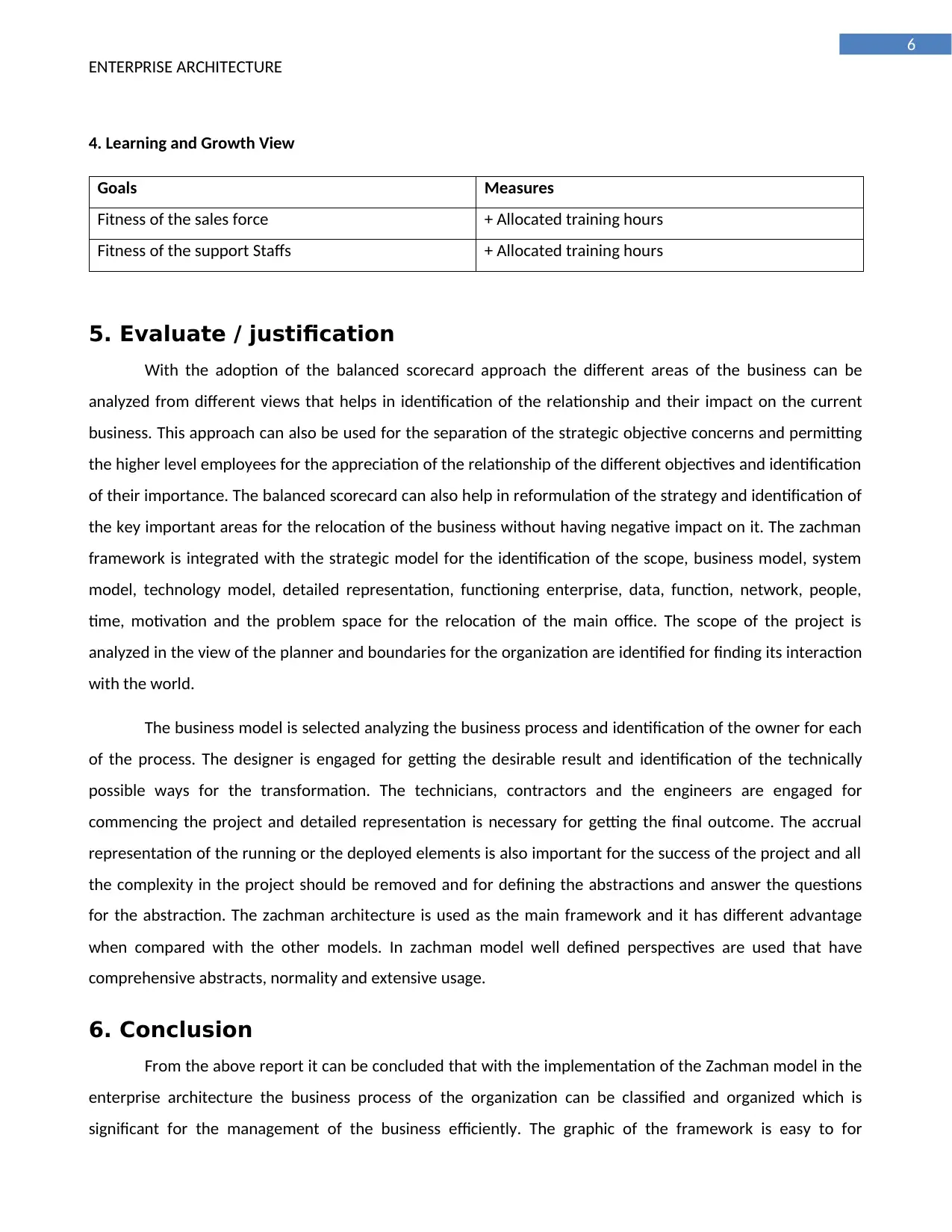
6
ENTERPRISE ARCHITECTURE
4. Learning and Growth View
Goals Measures
Fitness of the sales force + Allocated training hours
Fitness of the support Staffs + Allocated training hours
5. Evaluate / justification
With the adoption of the balanced scorecard approach the different areas of the business can be
analyzed from different views that helps in identification of the relationship and their impact on the current
business. This approach can also be used for the separation of the strategic objective concerns and permitting
the higher level employees for the appreciation of the relationship of the different objectives and identification
of their importance. The balanced scorecard can also help in reformulation of the strategy and identification of
the key important areas for the relocation of the business without having negative impact on it. The zachman
framework is integrated with the strategic model for the identification of the scope, business model, system
model, technology model, detailed representation, functioning enterprise, data, function, network, people,
time, motivation and the problem space for the relocation of the main office. The scope of the project is
analyzed in the view of the planner and boundaries for the organization are identified for finding its interaction
with the world.
The business model is selected analyzing the business process and identification of the owner for each
of the process. The designer is engaged for getting the desirable result and identification of the technically
possible ways for the transformation. The technicians, contractors and the engineers are engaged for
commencing the project and detailed representation is necessary for getting the final outcome. The accrual
representation of the running or the deployed elements is also important for the success of the project and all
the complexity in the project should be removed and for defining the abstractions and answer the questions
for the abstraction. The zachman architecture is used as the main framework and it has different advantage
when compared with the other models. In zachman model well defined perspectives are used that have
comprehensive abstracts, normality and extensive usage.
6. Conclusion
From the above report it can be concluded that with the implementation of the Zachman model in the
enterprise architecture the business process of the organization can be classified and organized which is
significant for the management of the business efficiently. The graphic of the framework is easy to for
ENTERPRISE ARCHITECTURE
4. Learning and Growth View
Goals Measures
Fitness of the sales force + Allocated training hours
Fitness of the support Staffs + Allocated training hours
5. Evaluate / justification
With the adoption of the balanced scorecard approach the different areas of the business can be
analyzed from different views that helps in identification of the relationship and their impact on the current
business. This approach can also be used for the separation of the strategic objective concerns and permitting
the higher level employees for the appreciation of the relationship of the different objectives and identification
of their importance. The balanced scorecard can also help in reformulation of the strategy and identification of
the key important areas for the relocation of the business without having negative impact on it. The zachman
framework is integrated with the strategic model for the identification of the scope, business model, system
model, technology model, detailed representation, functioning enterprise, data, function, network, people,
time, motivation and the problem space for the relocation of the main office. The scope of the project is
analyzed in the view of the planner and boundaries for the organization are identified for finding its interaction
with the world.
The business model is selected analyzing the business process and identification of the owner for each
of the process. The designer is engaged for getting the desirable result and identification of the technically
possible ways for the transformation. The technicians, contractors and the engineers are engaged for
commencing the project and detailed representation is necessary for getting the final outcome. The accrual
representation of the running or the deployed elements is also important for the success of the project and all
the complexity in the project should be removed and for defining the abstractions and answer the questions
for the abstraction. The zachman architecture is used as the main framework and it has different advantage
when compared with the other models. In zachman model well defined perspectives are used that have
comprehensive abstracts, normality and extensive usage.
6. Conclusion
From the above report it can be concluded that with the implementation of the Zachman model in the
enterprise architecture the business process of the organization can be classified and organized which is
significant for the management of the business efficiently. The graphic of the framework is easy to for
Paraphrase This Document
Need a fresh take? Get an instant paraphrase of this document with our AI Paraphraser
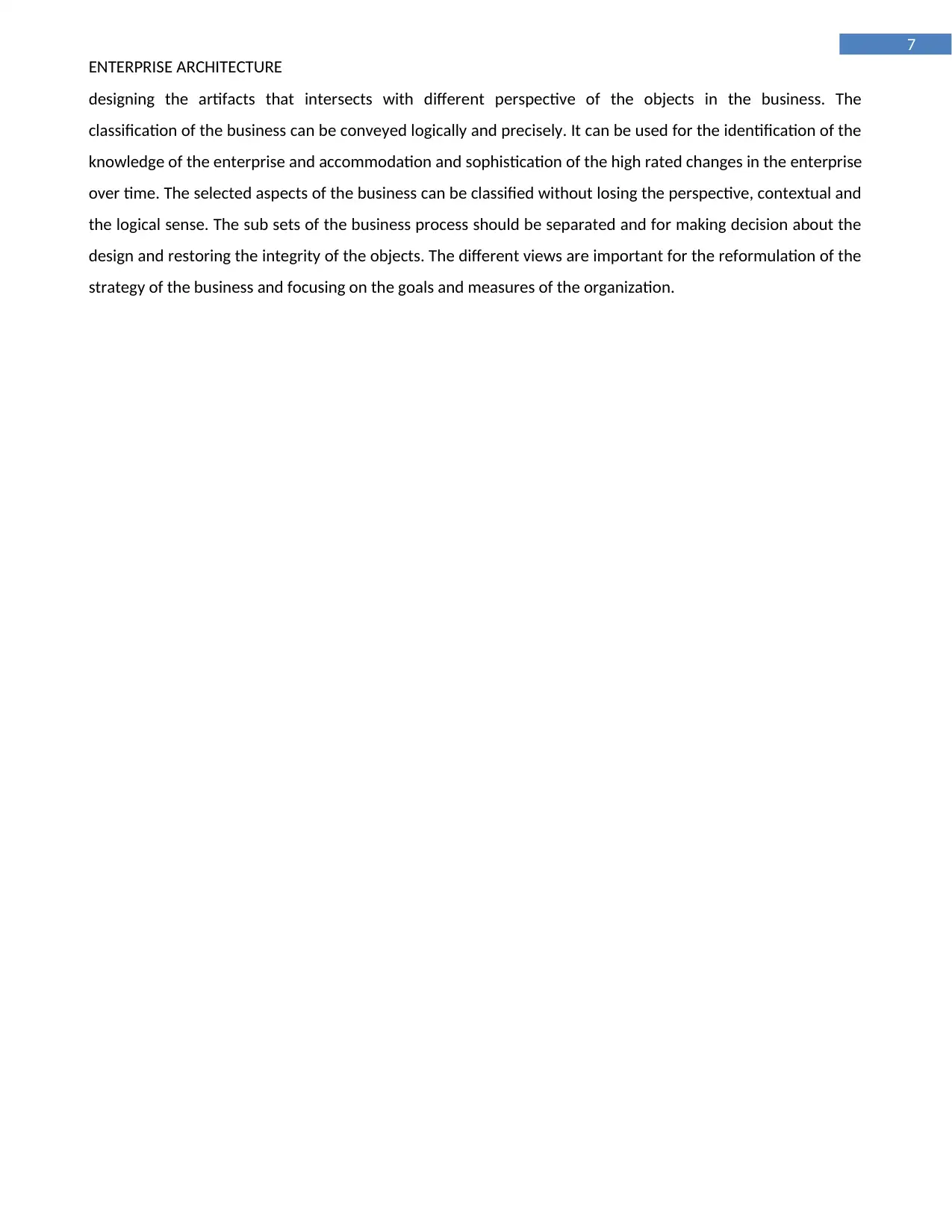
7
ENTERPRISE ARCHITECTURE
designing the artifacts that intersects with different perspective of the objects in the business. The
classification of the business can be conveyed logically and precisely. It can be used for the identification of the
knowledge of the enterprise and accommodation and sophistication of the high rated changes in the enterprise
over time. The selected aspects of the business can be classified without losing the perspective, contextual and
the logical sense. The sub sets of the business process should be separated and for making decision about the
design and restoring the integrity of the objects. The different views are important for the reformulation of the
strategy of the business and focusing on the goals and measures of the organization.
ENTERPRISE ARCHITECTURE
designing the artifacts that intersects with different perspective of the objects in the business. The
classification of the business can be conveyed logically and precisely. It can be used for the identification of the
knowledge of the enterprise and accommodation and sophistication of the high rated changes in the enterprise
over time. The selected aspects of the business can be classified without losing the perspective, contextual and
the logical sense. The sub sets of the business process should be separated and for making decision about the
design and restoring the integrity of the objects. The different views are important for the reformulation of the
strategy of the business and focusing on the goals and measures of the organization.
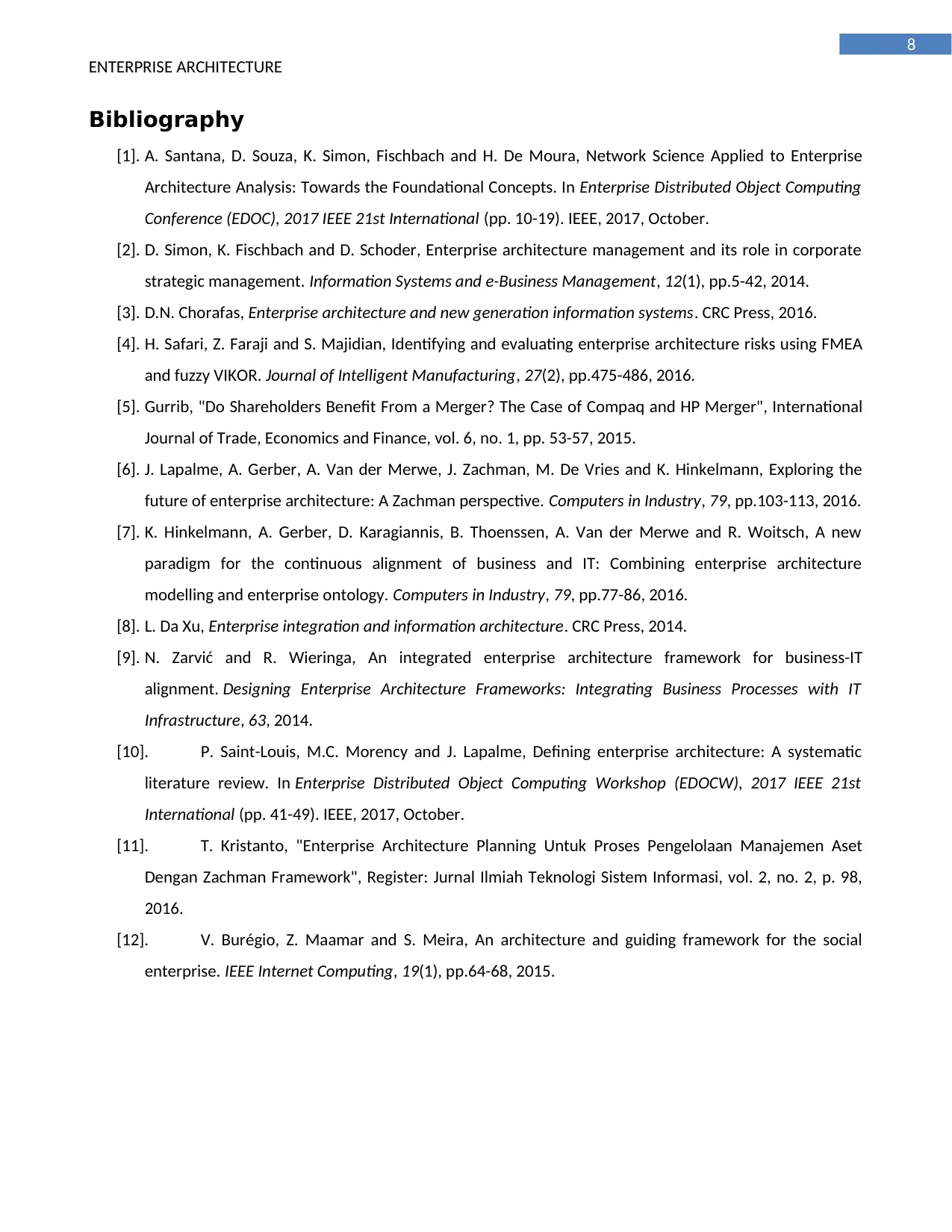
8
ENTERPRISE ARCHITECTURE
Bibliography
[1]. A. Santana, D. Souza, K. Simon, Fischbach and H. De Moura, Network Science Applied to Enterprise
Architecture Analysis: Towards the Foundational Concepts. In Enterprise Distributed Object Computing
Conference (EDOC), 2017 IEEE 21st International (pp. 10-19). IEEE, 2017, October.
[2]. D. Simon, K. Fischbach and D. Schoder, Enterprise architecture management and its role in corporate
strategic management. Information Systems and e-Business Management, 12(1), pp.5-42, 2014.
[3]. D.N. Chorafas, Enterprise architecture and new generation information systems. CRC Press, 2016.
[4]. H. Safari, Z. Faraji and S. Majidian, Identifying and evaluating enterprise architecture risks using FMEA
and fuzzy VIKOR. Journal of Intelligent Manufacturing, 27(2), pp.475-486, 2016.
[5]. Gurrib, "Do Shareholders Benefit From a Merger? The Case of Compaq and HP Merger", International
Journal of Trade, Economics and Finance, vol. 6, no. 1, pp. 53-57, 2015.
[6]. J. Lapalme, A. Gerber, A. Van der Merwe, J. Zachman, M. De Vries and K. Hinkelmann, Exploring the
future of enterprise architecture: A Zachman perspective. Computers in Industry, 79, pp.103-113, 2016.
[7]. K. Hinkelmann, A. Gerber, D. Karagiannis, B. Thoenssen, A. Van der Merwe and R. Woitsch, A new
paradigm for the continuous alignment of business and IT: Combining enterprise architecture
modelling and enterprise ontology. Computers in Industry, 79, pp.77-86, 2016.
[8]. L. Da Xu, Enterprise integration and information architecture. CRC Press, 2014.
[9]. N. Zarvić and R. Wieringa, An integrated enterprise architecture framework for business-IT
alignment. Designing Enterprise Architecture Frameworks: Integrating Business Processes with IT
Infrastructure, 63, 2014.
[10]. P. Saint-Louis, M.C. Morency and J. Lapalme, Defining enterprise architecture: A systematic
literature review. In Enterprise Distributed Object Computing Workshop (EDOCW), 2017 IEEE 21st
International (pp. 41-49). IEEE, 2017, October.
[11]. T. Kristanto, "Enterprise Architecture Planning Untuk Proses Pengelolaan Manajemen Aset
Dengan Zachman Framework", Register: Jurnal Ilmiah Teknologi Sistem Informasi, vol. 2, no. 2, p. 98,
2016.
[12]. V. Burégio, Z. Maamar and S. Meira, An architecture and guiding framework for the social
enterprise. IEEE Internet Computing, 19(1), pp.64-68, 2015.
ENTERPRISE ARCHITECTURE
Bibliography
[1]. A. Santana, D. Souza, K. Simon, Fischbach and H. De Moura, Network Science Applied to Enterprise
Architecture Analysis: Towards the Foundational Concepts. In Enterprise Distributed Object Computing
Conference (EDOC), 2017 IEEE 21st International (pp. 10-19). IEEE, 2017, October.
[2]. D. Simon, K. Fischbach and D. Schoder, Enterprise architecture management and its role in corporate
strategic management. Information Systems and e-Business Management, 12(1), pp.5-42, 2014.
[3]. D.N. Chorafas, Enterprise architecture and new generation information systems. CRC Press, 2016.
[4]. H. Safari, Z. Faraji and S. Majidian, Identifying and evaluating enterprise architecture risks using FMEA
and fuzzy VIKOR. Journal of Intelligent Manufacturing, 27(2), pp.475-486, 2016.
[5]. Gurrib, "Do Shareholders Benefit From a Merger? The Case of Compaq and HP Merger", International
Journal of Trade, Economics and Finance, vol. 6, no. 1, pp. 53-57, 2015.
[6]. J. Lapalme, A. Gerber, A. Van der Merwe, J. Zachman, M. De Vries and K. Hinkelmann, Exploring the
future of enterprise architecture: A Zachman perspective. Computers in Industry, 79, pp.103-113, 2016.
[7]. K. Hinkelmann, A. Gerber, D. Karagiannis, B. Thoenssen, A. Van der Merwe and R. Woitsch, A new
paradigm for the continuous alignment of business and IT: Combining enterprise architecture
modelling and enterprise ontology. Computers in Industry, 79, pp.77-86, 2016.
[8]. L. Da Xu, Enterprise integration and information architecture. CRC Press, 2014.
[9]. N. Zarvić and R. Wieringa, An integrated enterprise architecture framework for business-IT
alignment. Designing Enterprise Architecture Frameworks: Integrating Business Processes with IT
Infrastructure, 63, 2014.
[10]. P. Saint-Louis, M.C. Morency and J. Lapalme, Defining enterprise architecture: A systematic
literature review. In Enterprise Distributed Object Computing Workshop (EDOCW), 2017 IEEE 21st
International (pp. 41-49). IEEE, 2017, October.
[11]. T. Kristanto, "Enterprise Architecture Planning Untuk Proses Pengelolaan Manajemen Aset
Dengan Zachman Framework", Register: Jurnal Ilmiah Teknologi Sistem Informasi, vol. 2, no. 2, p. 98,
2016.
[12]. V. Burégio, Z. Maamar and S. Meira, An architecture and guiding framework for the social
enterprise. IEEE Internet Computing, 19(1), pp.64-68, 2015.
⊘ This is a preview!⊘
Do you want full access?
Subscribe today to unlock all pages.

Trusted by 1+ million students worldwide
1 out of 9
Related Documents
Your All-in-One AI-Powered Toolkit for Academic Success.
+13062052269
info@desklib.com
Available 24*7 on WhatsApp / Email
![[object Object]](/_next/static/media/star-bottom.7253800d.svg)
Unlock your academic potential
Copyright © 2020–2025 A2Z Services. All Rights Reserved. Developed and managed by ZUCOL.




